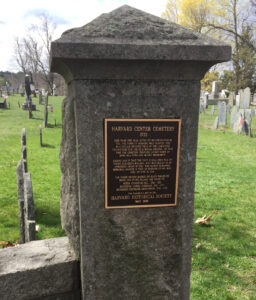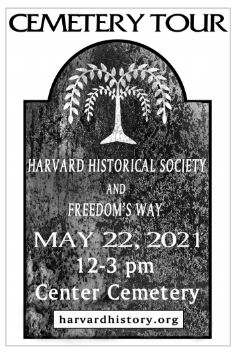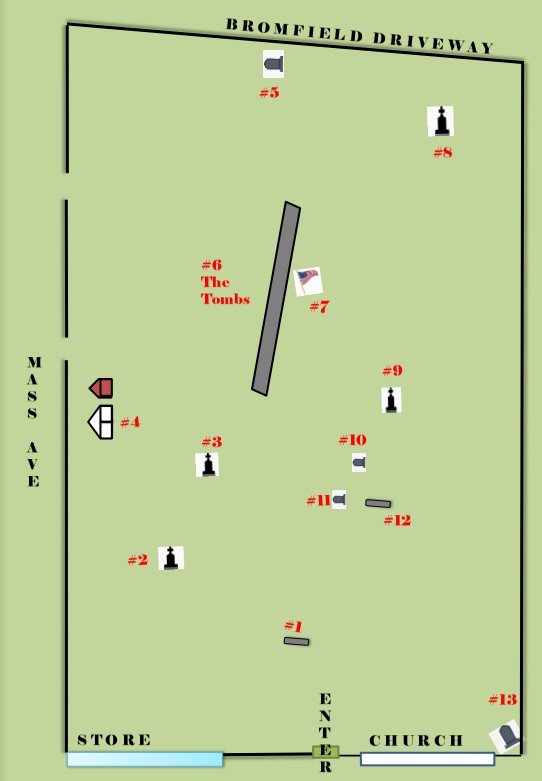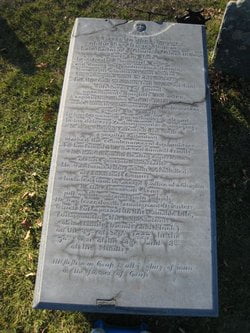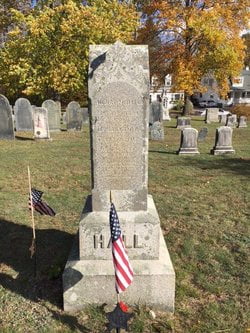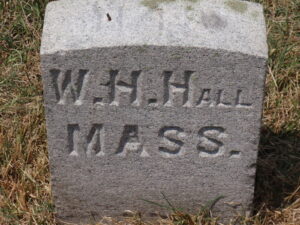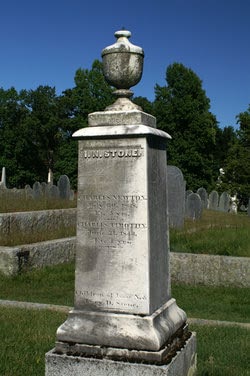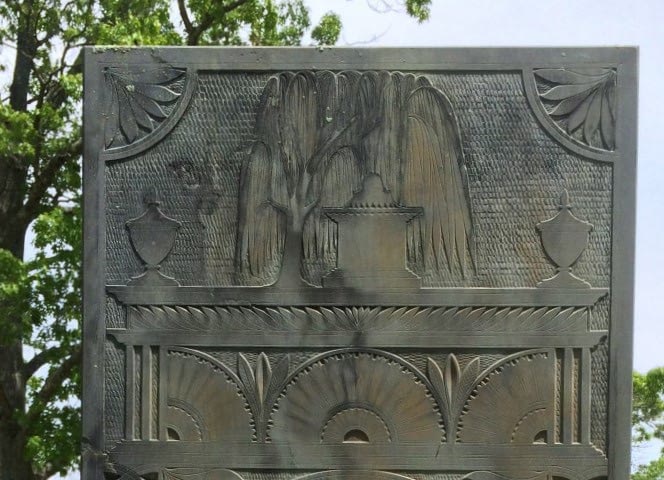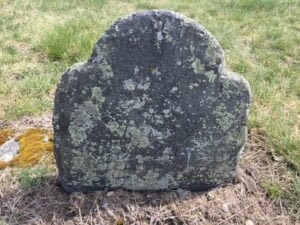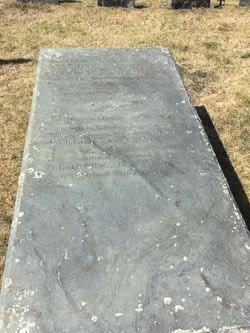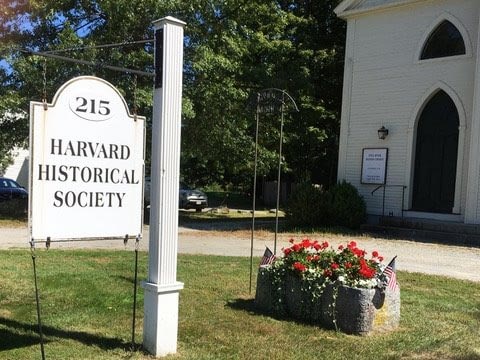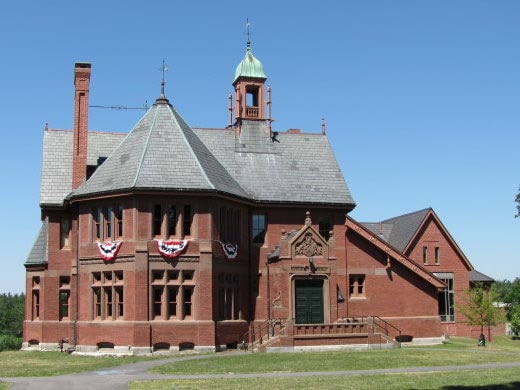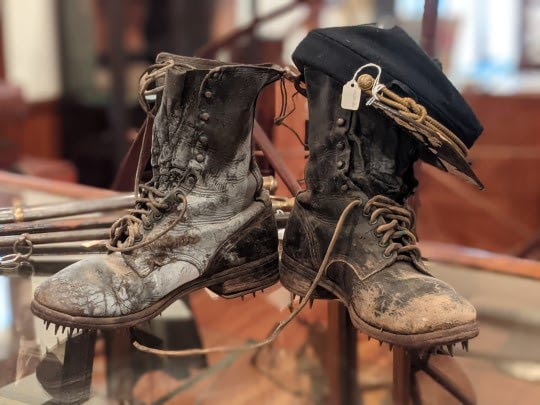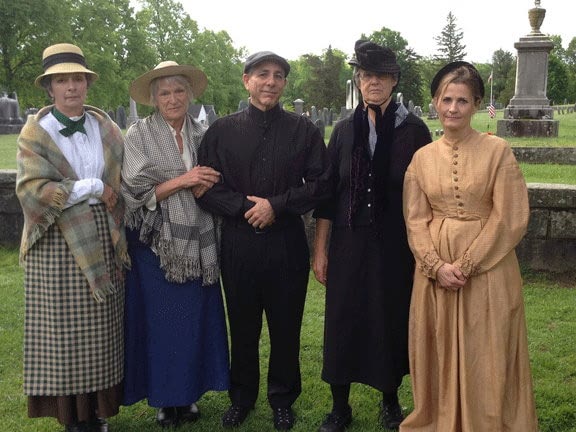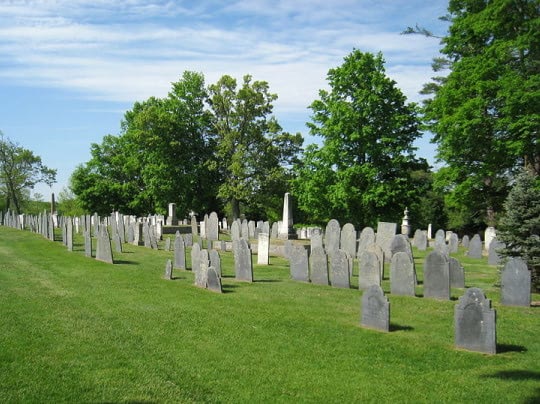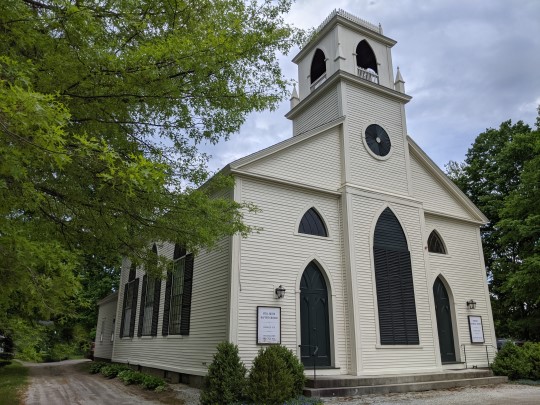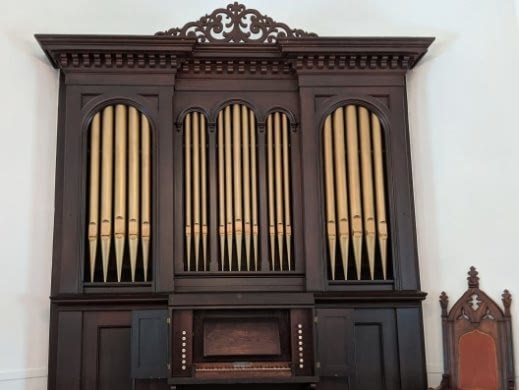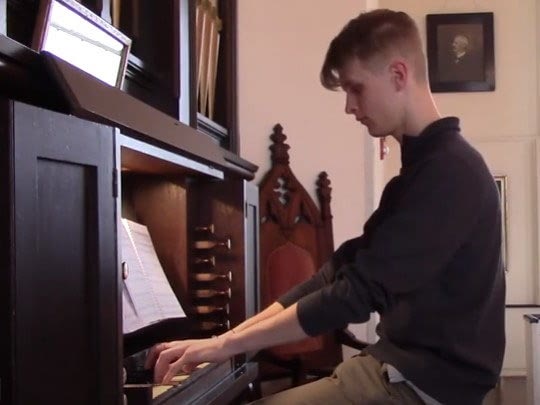Center Cemetery
Visit the resting places of the people who made Harvard.
This tour through time explores the days of the town's incorporation through the late 20th century and the lives of Founding Fathers Simon Stone and Peter Atherton, the slave Othello, black Civil War soldier William Henry Hall, stone cutter Isaac Stone, philanthropist Margaret Blanchard, and adventurer William Savage.
Each of these former residents pursued their dream of creating a better world for their children and each contributed to making Harvard a better place today. Whether you come and join us, are guided by our website or our guide booklet, this tour is fun for all ages.
Self-guided Tour
You can do the self guided tour using the online information below or you can download the Cemetery Tour Booklet here under.
When visiting the Cemetery, please remember:
- Visitors are kindly asked to respect the graves and cemetery property while enjoying the tour.
- Please refrain from touching or sitting on grave markers. Grave rubbing is not allowed.
- For everyone’s safety, please be courteous and practice social distancing.
Grave Facts
First buried - Elizabeth Willard, 1716 - 1733
First stone - Ephraim Stone, 1716-1734
Last Burial - Phyllis Arlene Buddington 1943-2009
Total number of burials – c. 2,311
Total Number of Males - 1076
Total Number of Females - 1,216
Children 18 & Under - 506
Over 90 years - 81
Longest Lives:
Rebecca Huse – 103 years, 2 months, 12 days
Absolom Ball Gale – 100 Years, 16 days
Most Popular Female Name - Mary 133
Most Popular Male Name - John 83
Most frequent surnames – Whitney 142, Willard 121
Rev. Daniel Johnson
May 14, 1747 – Sept 23, 1777Daniel Johnson was born on May 24, 1747. A graduate of Harvard College in 1767, he studied for his profession with Reverend Matthew Bridge of Framingham. Reverend Johnson accepted the second invitation from Harvard to become the church’s third minister at 143 pounds, 6 shillings, 8 pence. The town also gave him land on the Southeast corner of the commons as a house lot.
He married Betsey Lee of Manchester and they had four children: Nabby Lee (1771), Daniel (1772-74), Joanna (1774), and Lucy (1778), born after Reverend Johnson had died from dysentery(1777). Reverend Johnson was known for his magnetic personality and stirring oratory. During his eight years as minister in Harvard, Reverend Johnson admitted 93 to the church, baptized 371, married 91 couples and attended 132 funerals. He filled the church with his sermons, calling for a larger building. The second meetinghouse, like the first, was located at the site of the current Unitarian Church. Reverend Johnson joined the Patriot Army in 1776 and was appointed Chaplain in the Continental Army. He died of dysentery soon after. In January 1778 at Town Meeting, it was voted that a special stone marker be placed at his grave. It is a large, horizontal stone, supported by four pillars.
Its inscription reads:
“Sacred to the Memory of the Reverend Daniel Johnson Late Pastor of the Church of Christ in Harvard; early in Life he entered the Ministerial office and during his continuance therein shone with a brilliancy and Lustre surpassing the most of his order. For the God of Nature had endowed him with Powers of mind uncommonly sprightly and active. A copious inventions & ready utterance made him in extemporaneous performances greatly to excel. In his sermons he was orthodox and elegant; In his delivery zealous, popular and engaging; So that when he ascended the desk a peculiar attention marked the countenances of his auditory To his friends he showed himself friendly, who had frequent pleasing experience of his generous hospitality. He was formed for action and possessed of a martial Genius which lead him to accept the office of a Chaplain in the American Army, just on his entrance into which He was seized with a malignant Dysentery, which put a period to his valuable Life, (disappointing the expectations of his family friends and Flock.) On the 23rd of September, 1777. In the 30th year of his age and 8th of his Ministry. All flesh is Grass all the glory of man as the flower of Grass.”
William Henry Hall
1843 - 1864William Henry Hall, a person
of color, born in Harvard on March 26, 1842, was the son of Henry and Jerusha Smith Hall. He worked as a farmer and day laborer according to
the 1860 US Census. At age 19, on August 18, 1862, he enlisted with the Union Army fighting in the Civil War. William mustered into Company "G", 36th Massachusetts Infantry and eventually was promoted to Corporal. William’s Company saw action in many battles, including Fredericksburg, Vicksburg, and The Wilderness.
He was killed at Spotsylvania Court House in Virginia on May 12, 1864, at 21 years of age and buried in Fredericksburg, Va. His parents added his name to their memorial to honor his memory and service.
Florence (Burt) Haskell
May 1840 – Oct. 1870Florence “Flora” Harriet Burt was born in May 1840 to George and Harriet (Hildreth) Haskell.
Her father, George, was known for his many inventions, notably the American hay tedder. This implement stirred and spread cut hay so that it could dry evenly. Although he wished Flora were a boy, George Burt sent Flora to be educated at the Groton Academy, now called Lawrence Academy. She was fortunate to attend through high school, unusual for a girl in those times. Harvard education did not include high school.
She finished schooling just as the first wave of soldiers was called to war. Flora was inspired to join the war effort as a nurse, serving under Dorothea Dix who was recruiting for an all female corps of nurses. Prior to this, all military nurses were men. At age 22, Flora joined the war and went to Washington.
Some of her duties as a nurse were dressing wounds, feeding invalids, writing letters for patients, tending to their spiritual needs and informing families of deaths.
She met Joseph Haskell, Company C of the 19th Maine Regiment, in 1864 when he was transferred to the Invalid Corps where she may have cared for him. (This was not the same James Haskell from Harvard who died in the war.) They were married on September 20, 1866 in Baltimore, Maryland. They had one child, Harriet (Hattie) Burt Haskell who had the same red hair and blue eyes of her father.
Flora died in Harvard at the age of 30 from consumption and is buried here in the Center Cemetery. After Flora’s death, Joseph married Sally Catherine Hartman in Baltimore, Maryland. They had at least one child together, Raymond (1878 – 1918).
Harriet remained in Harvard and lived with the Burt family. Flora’s family lived on what is now Ayer Road in the Mill district. Her father, George Burt owned a mill and had a machinery workshop. None of these buildings are still standing.
The Hearse House
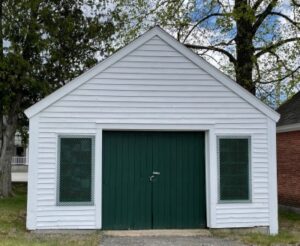 In 1808 the town purchased a hearse wagon and a harness and built a small house at the northwest border of the burying ground in which to keep the new equipment. Both the hearse house and the town pound had to be moved in 1821 to make way for the Congregational Church. The hearse house was moved across the cemetery, along the wall by the eastern entrance on Mass. Ave. In 1846 it was replaced by the present white wooden structure, now used as a shed.
In 1808 the town purchased a hearse wagon and a harness and built a small house at the northwest border of the burying ground in which to keep the new equipment. Both the hearse house and the town pound had to be moved in 1821 to make way for the Congregational Church. The hearse house was moved across the cemetery, along the wall by the eastern entrance on Mass. Ave. In 1846 it was replaced by the present white wooden structure, now used as a shed.Public Tomb
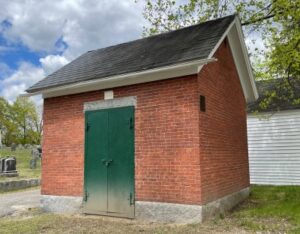 Adjacent to the south of the hearse house is a square brick “Public Tomb,” built in 1884 as a temporary resting place until burial could be arranged. It was no longer in use after 1892, when the center cemetery closed.
Adjacent to the south of the hearse house is a square brick “Public Tomb,” built in 1884 as a temporary resting place until burial could be arranged. It was no longer in use after 1892, when the center cemetery closed.William Henry Savage
Nov. 21, 1830 – Dec. 28, 1916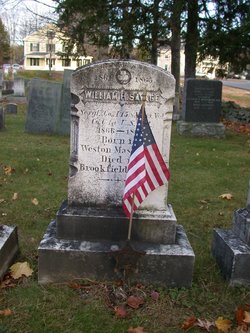 Born to Charles and Anna (Thacher) Savage November 21, 1830, William Henry Savage's thirst for adventure was probably inspired by his early life. As a child he grew up around ships captained by his father, Charles Tyler Savage and survived a shipwreck when he was just a year old. In 1849, at the age of 18, he journeyed first to California then to Australia in search of gold. In 1855, he returned to Massachusetts to their newly
Born to Charles and Anna (Thacher) Savage November 21, 1830, William Henry Savage's thirst for adventure was probably inspired by his early life. As a child he grew up around ships captained by his father, Charles Tyler Savage and survived a shipwreck when he was just a year old. In 1849, at the age of 18, he journeyed first to California then to Australia in search of gold. In 1855, he returned to Massachusetts to their newly
purchased farm in Harvard. When the Civil War began in 1861 he was among the first from Harvard to enlist in the Union Army. Joining Co. A of the 15th Massachusetts Regiment, he was wounded by shell fragments at Gettysburg, July 2, 1862. After a short convalescence in Harvard, William returned to the war as a member of the artillery corp. Finally, in 1865, he settled on the family farm in Harvard and helped raise eight children. Later, he became an avid bicycler and rode nearly 80 miles a day exploring New Hampshire's White Mountains, the Berkshires and even on a two week sojourn to Montreal and back. William Henry Savage died on December 28,1916.

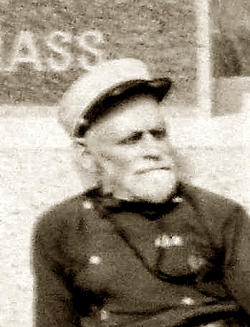
The Tombs
 At the Town Meeting of October 1, 1827, townspeople voted “to give Liberty to build tombs” under the directions of a committee of five men.
At the Town Meeting of October 1, 1827, townspeople voted “to give Liberty to build tombs” under the directions of a committee of five men.
Unfortunately, the committee miscalculated and uncovered human remains while they were building the first tombs. The work stopped, and at the next annual Town Meeting, the committee was ordered to build their tombs “where they will neither disturb the dead nor offend the living.”
Twelve tombs in a row, running vertically north to south, were built into mounded earth toward the southern end of the burying ground.
The first burial in the tombs was John Fairbank in 1828, and it seems the bodies of four family members who had died earlier may have been relocated to his tomb. The last tomb burial was James Nourse in 1888. In all, there are 47 people buried in the tombs, with 10 in tomb seven and just one in tombs two and six.
Founders Memorial
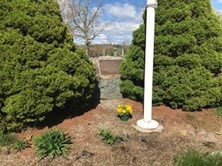 On Memorial Day 1995 the Harvard Cemetery Commission presented and dedicated a Founders Memorial in a ceremony on top of the tomb area in the old burying ground. The upright stone and plaque commemorate the 200 or so early settlers who came to Harvard, lived here, and were buried in unmarked graves. The plaque pays tribute to how the settlers “left their homes and families in search of new freedoms, a new way of life,” and they “pressed on, enduring all, to realize their dream, a town called “Harvard.’” The stone is from the Pin Hill Quarry and is a gift of the Saxl family.
On Memorial Day 1995 the Harvard Cemetery Commission presented and dedicated a Founders Memorial in a ceremony on top of the tomb area in the old burying ground. The upright stone and plaque commemorate the 200 or so early settlers who came to Harvard, lived here, and were buried in unmarked graves. The plaque pays tribute to how the settlers “left their homes and families in search of new freedoms, a new way of life,” and they “pressed on, enduring all, to realize their dream, a town called “Harvard.’” The stone is from the Pin Hill Quarry and is a gift of the Saxl family.Margaret B. Blanchard
November 10, 1787 – November 29, 1876Margaret Bromfield Blanchard is best remembered as the founder of a secondary school in Harvard, a school that encouraged education for young women as well as young men.
The Bromfield School, opened in 1878, was the fulfillment of a longstanding dream, and it brought together Margaret’s love of Harvard and her passion for education. Before then anyone aspiring to a college education had to enroll in one of the academies in Groton.
Born in Cambridge in 1787, Margaret spent time as a child visiting her grandfather’s home in Harvard. Col. Henry Bromfield was one of the town’s earliest and most notable residents. His mansion, which burned in 1855, was on the site of the old Bromfield School, now part of Harvard’s Public Library.
At the age of 38, Margaret married Rev. Ira Blanchard, pastor of the First Unitarian Society in Harvard. They left Harvard to travel in search of a mild climate for his poor health. When he died, Margaret returned to Harvard at the age of 62. At that time, her brother Henry and his wife were living in the old mansion. With bequests she had received from relatives, 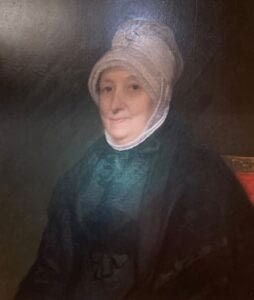 Margaret was able to build a lovely house at 35 Oak Hill Road where from her second floor sitting room she could see her grandfather’s house and beyond to the pond.
Margaret was able to build a lovely house at 35 Oak Hill Road where from her second floor sitting room she could see her grandfather’s house and beyond to the pond.
Margaret viewed her inherited money as a sacred trust, deposited temporarily in her hands to be used for the common good, and when the Bromfield mansion burned, Margaret purchased the site of the old homestead and six acres, with the thought that it would be a perfect place for a school. She and her brother Henry had often talked about building a secondary school in Harvard as a tribute to their grandfather. In her will she provided land and money to build a school, and in 1878 the Bromfield academy opened.
Isaac Newton Stone
December 23, 1799 – October 4, 1870Much of the slate used for gravestones throughout Harvard and the surrounding towns came from Harvard’s Pin Hill Quarry. According to Henry Nourse in History of Harvard, the first mention of this industry comes from the description of a lot of land as “where rocks have been dug for grave-stones,”. In the mid to late 19th century Nourse writes that “Some of these workmen kept in stock a collection of head and footstones, assorted sizes, set up in a grim row by the roadside to attract purchases. “
In 1839 Isaac N. Stone moved from Groton to 23 Fairbank St., Harvard and formed a partnership with Benjamin K. Park. For the next 24 years Park and Stone dominated the stone cutting business.
Their stones can be found throughout much of eastern & central Massachusetts as well as southern New Hampshire. Isaac Stone was recognized for his Weeping Willow design and for signing his stones “I.N. Stone – Harvard”. He retired in 1863 and returned to Groton, Ma. Isaac Stone died in Charlestown, Ma. Oct 4, 1870.
Simon Stone
August 1, 1686 – October 22, 1746Simon Stone, born c.1686, foremost citizen and founder of Harvard, was the descendent of Deacon Simon Stone of Watertown who came to America in 1635. The Stone family eventually settled in Groton family and, in 1716, Simon was deeded 100 acres from Jonas Prescott bounded by Old Mill Brook to Cold Spring Brook to the Robbins and Farnsworth properties.
Records of the General Court show, beginning in 1729-30, Simon Stone and seven others journeyed many trips to Boston bringing forward a proposition to set off a new town of 4850 acres with lands from Lancaster, Groton and Stow. The formal petition of incorporation was presented to the Massachusetts House of Representatives in 1730 and officially incorporated on June 20, 1732.
Simon Stone, named as one of the principal inhabitants of the new town, was empowered to “Assemble and Convene the Inhabitants of said Town to Chuse Town Officers” thus issuing Harvard’s first town warrant. Simon Stone’s civic and religious involvement in Harvard included many elected terms as a Selectman as well as serving as Harvard’s first
moderator. He procured funding for the wages and construction of the new Meetinghouse completed by 1733. He, along with Joseph Fairbank, Jonathan Whitney, and Joseph Haskell, organized the ordination in October 1733 of John Secomb as the minister. Simon also became a Deacon.
Simon Stone, founding father of the town of Harvard, died in 1746. His widow, Sarah and eldest son, Simon, settled his estate, land and personal property valued at approximately 540 pounds. He was regarded as a man of the utmost in thrifty yeomanry who lived a simple personal life, yet his life stands in Harvard’s history as one of the greatest.
Peter Atherton
1705 – June 13, 1764Peter Atherton was Harvard’s first town clerk, and in that role, he entered the first records in the town books. He also served the town as assessor 15 times and as selectman 11. Atherton was the town’s first representative to the General Court, and he was appointed resident justice in 1745.
Atherton and his wife, Experience, are buried in the same grave, something that was very unusual. The inscription on the stone reads:
One solitary mansion encloses their remains
Companions in life they have the consolation
Of not being separated in death – if indeed
consolation can be found in the grave.
This monument is erected to their memory,
which will ever be dear to the sons and daughters of virtue and religion.
Othello
c. 1746 – 1818In 1765 there were twelve inhabitants of African descent in Harvard. The majority were probably "servants for life" as enslaved people were then called. Othello, called "Thurlo", was owned by Colonel Henry Bromfield.
According to Nourse's History of Harvard, Othello was "an eccentric character, as well known in Harvard as his master." He was born in Africa, bought in England and then brought to America about 1760. Later, after being given his freedom, he chose to remain with the Bromfield family and became an inseparable attendant to the colonel, who was by then a widower living alone in his mansion. Othello's grave stands by itself in the extreme northwest corner of Harvard’s Center cemetery, behind the Congregational Church, at least 25 feet from any other grave in the cemetery.
The small slate marker reads:

